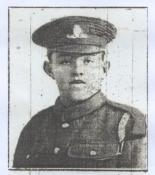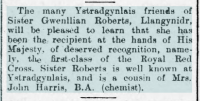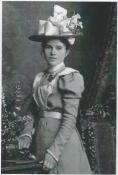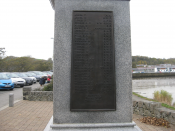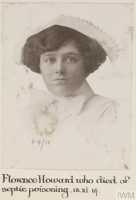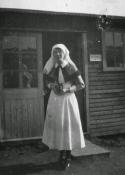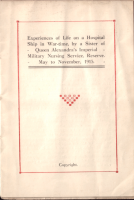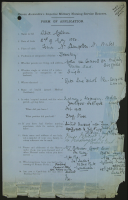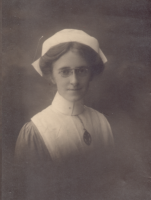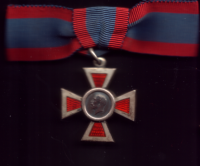Browse the collection
Sorted by occupation
Megan Davies
Place of birth: Aberdare
Service: Singer, bank clerk
Death: 1919/03/25, Aberdare, Influenza / y ffliw
Notes: Megan Davies was a well-known contralto soloist in the Aberdare area, and performed in several War Heroes concerts. She worked in Barclay’s Bank, Merthyr.
Reference: WaW0421
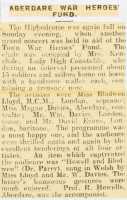
Newspaper report
Newspaper report of a War Heroes Concert, naming Megan Davies. Aberdare Leader 5th January 1918.

Newspaper report
Report of the death from influenza of Megan Davies, aged 29. Aberdare Leader 29th March 1919
Edith Richards
Service: Sister
Notes: Mother, Mimmi (Sarah) and sister, Edith, to her left, at Tom’s graveside, c.1920; Gunner Thomas Sidney Richards,‘killed in action’, Armentieres, France, 14 March 1918, aged 20 in northern France, c. 1920
Reference: WaW0080
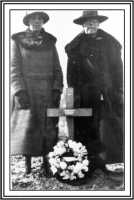
Edith and Mimmi (Sarah) Richards
Photograph of Edith and Mimmi (Sarah) Richards, Mother and sister of Gunner Thomas Sidney Richards, at his grave in France, c.1920; Tom Richards was ‘killed in action’, Armentieres,France
Gwenllian Elizabeth Roberts
Place of birth: Llangynidr
Service: Sister, QAIMNS Reserve
Notes: Gwenllian Roberts was awarded the Royal Red Cross for her services at the Central Military Hospital, Chatham, Kent.
Reference: WaW0115
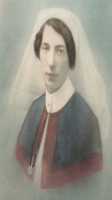
Gwenllian Elizabeth Roberts
Sister Gwenllian Elizabeth Roberts QAIMNSR wearing her Royal Red Cross medal
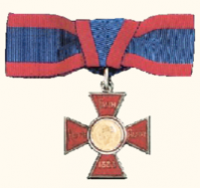
Gwenllian Roberts’s Royal Red Cross
Sister Gwenllian Roberts’s Royal Red Cross, awarded August 5th 1919.
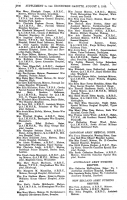
Edinburgh Gazette listing Sister Roberts’s award
Edinburgh Gazette listing Sister Roberts’s award, August 5th 1919 (8th in the right hand column).
Hannah Davies
Place of birth: Glog, Pembrokeshire
Service: Sister
Death: 1918 ?, Glog, Pembrokeshire, Influenza / Ffliw
Notes: Hannah was the sister of two soldiers, William and John, both serving overseas. John, the younger, was killed and is buried in Jerusalem. William survived, but brought home Spanish flu. He survived that too, but Hannah caught it nursing him, and died. Letters from both brothers, in Welsh and English, survive.
Reference: WaW0243
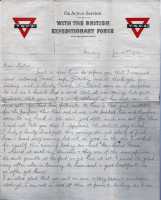
Letter
Letter in English from William to Hannah Davies, written on YMCA paper, on January 21st, 1918.
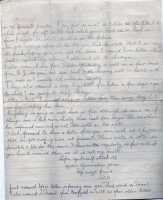
Letter (reverse)
Reverse of letter in English from William to Hannah Davies, written on YMCA paper, on January 21st, 1918.
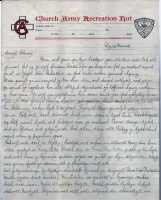
Letter
Letter in Welsh from William to Hannah Davies, written on Church Army Recreation Hut paper. Winter 1917-18

Letter (reverse)
Letter in Welsh from William to Hannah Davies, written on Church Army Recreation Hut paper. Winter 1917-18 (reverse)rn
Gladys Butler
Place of birth: Valleys, 1914
Service: Small child
Notes: Gladys Butler had vivid memories of being dressed in a miniature soldier's uniform (c.1916/17) and being stood on a table. When admired as a 'smart soldier boy', she insisted 'I'm not a boy, I'm a girl!' (CF November 2014)
Reference: WaW0090
Arvona (Fona) Powell Jones
Place of birth: Gorseinon July 10th, 1913
Service: Small child
Notes: Fona confirmed her address and date of birth: July 10th, 1913. She recalled a story about her mother during the First World War asking her, because her father had received call-up papers, ‘You don’t want your father to go to war do you? She replied’ ‘Oh! Yes!’, because she had seen her uncle, who was at sea, in a uniform with a whistle around his neck. She thought therefore that her father would have a uniform and a whistle too. So she was delighted at the prospect of her father dressed in a uniform and whistle. But she remembers her mother’s face falling. ‘Oh! She was terribly disappointed that I had said that I wanted my father to go to war.’ But her father worked in the steelworks and since steel was required during the war he worked there for the duration of the war. Her parent’s names were Mary Ann Powell and Richard Jones; her father came from Cydweli and her mother was local to Gorseinon area. Her father had worked in the steelworks in Cydweli too. She also talks of her uncle, Brynmor, who was in the navy and who hated the war. At the end of the war he gave his navy clothes to her mother and told her to do what she wanted with them. She made Fona a dress from the bell-bottoms – they were of serge and added flowers etc onto it. She wore it all the time – to chapel and all. This was when she was about 5-6 years old. She remembers wearing it and swinging of a tree branch in it. Her mother’s brother (Tom in 1915 according to the family’s family tree)) died of typhoid in Crystal Palace during the war and she has a photograph of a wedding during the war with the men dressed in black in memory of him. Another of her mother’s brothers (Baden) was called up but when he arrived at the mess plates were being thrown all over the place. The Armistice – peace agreement had just been signed. And that’s all he saw of the war. Fona also recalled how, for the duration of the war, her mother removed a model of an eagle which was on top of the family’s grandfather clock and stored it away in a drawer, because it was a reminder and symbol of Germany. After the war it was restored to its place on top of the clock! ‘Memory is a strange thing isn’t it.
Sources: fona_jones_gorseinon.wave_sound
Reference: WaW0075
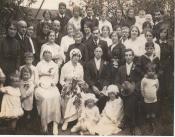
Fona Jones bottom left (blurred) at family wedding.
A family wedding showing a blurred Fona Jones, bottom left. The women were all dressed in mourning for Fona's uncle Tom, who had died in 1915.
Margaret Evans Thomas
Place of birth: Pwllheli
Service: Staff Nurse, TFNS, 1914 - 1918
Death: 1918-11-08, 1st London General Hospital, Pneumonia
Memorial: War Memorial; Nurses Memorial; St Bartholomew's Hospital, Pwllheli; St Asaph, Caernarfon; Flintshire; London
Notes: Margaret, from a Welsh-speaking family, was brought up in Pwllheli from the age of 9 by her aunt and uncle. She probably trained as a nurse in London, perhaps at St Bartholemew’s Hospital which became the 1st London General Hospital. During the war she served as a Staff Nurse there until her death from flu at the age of 28; she was described as ‘cheerful and willing’. The War Office paid her funeral expenses of £20 2s 0d. Her gravestone in Pwllheli cemetery is set with the commemorative plaque (dead man’s penny’) sent to her relations after the war. Her name also appears on the Nurses’ Memorial in St Asaph’s cathedral. Thanks to Wayne Bywater.
Sources: http://www.flintshirewarmemorials.com/memorials/st-asaph-memorial/st-asaph-cathedral-welsh-nurses-ww1/thomas-margaret-evans WO-399-14971
Reference: WaW0017
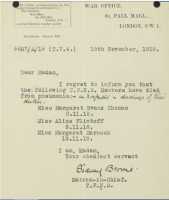
Letter
Letter from Miss Sidney Brown to Agnes Conway of the Womens Section of the Imperial War Museum listing Margaret’s name as having died of pneumonia.
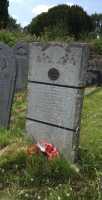
Grave of Margaret Evans Thomas
Margaret Evans Thomas’s grave in Pwllheli cemetery, set with her ‘dead man’s penny’. Thanks to Veronica Ruth.
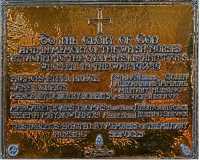
Nurses memorial St Asaphs Cathedral
Name of Margaret Evans Thomas on the Nurses' Memorial, St Asaph's Cathedral
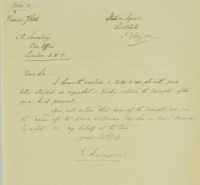
Letter
Letter from Margaret’s aunt Mrs Summers, explaining the differing names on her funeral payments.
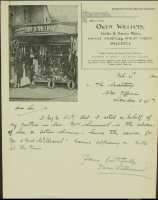
Letter
Letter from Mrs Summers’s son in law, explaining the differing names on Margaret’s funeral payments.
Florence Gwendolin Howard
Place of birth: Pontypridd ?
Service: Staff Nurse, Territorial Nursing Service/Gwasanaeth Nyrsio Tiri
Death: 1914-11-18, Not known, Septic poisoning / Gwenwyno septig
Memorial: St Catherines Church, grave Glyntaff Cemetery, Pontypridd, Glamorgan
Notes: Nothing is currently known of Florence Howard.
Sources: http://twgpp.org/information.php?id=2257521; http://www.qaranc.co.uk/war_graves_memorials_Nurse/Nyrss.php
Reference: WaW0026
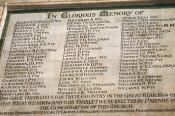
St Catherine’s Church, Pontypridd
Name of Florence Howard on war memorial plaque in St Catherine’s Church, Pontypridd
Gertrude Madley
Place of birth: Llanelli, 1892
Service: Staff Nurse, QAIMNS Reserve / Wrth gefn, September 1916 - May 1920
Notes: Gertrude Madley was the daughter of a tinplate rollerman, and worked as a tinplate hand before training as a nurse in Swansea in 1913. She joined Queen Alexandra's Imperial Military Nursing Service Reserve as a Staff Nurse in September 1916. At just twenty-three years of age she was one of the youngest nurses to serve with the Reserve during the Great War. She served initally in Malta, and then, 1918 - 1920, in France
Sources: http://greatwarnurses.blogspot.co.uk/2014/09/from-small-acorns-mighty-oaks-grow.html
Reference: WaW0098
Alice Meldrum
Place of birth: Trevor Llangollen, 1880
Service: Staff Nurse, QAIMNS Reserve / Wrth gefn, 1914 - 1920
Notes: Alice Meldrum survived the sinking of the Hospital Ship HMHS Anglia 17th November 1915. The ship was carrying wounded men from Boulogne to Folkestone when it struck a mine. Alice's account reads:“We carried as many as possible on deck, and those that could threw themselves into the sea; others were let down in the lifeboat, but unfortunately it was only possible to lower one boat, as the ship was sinking so rapidly. The patients kept their heads wonderfully, there was no panic whatever, and when one realises that in the vast majority of cases they were suffering from fractured limbs, severe wounds, and amputations, it speaks volumes for their spirit, their grit and real bravery for they must have suffered agonies of pain. After we had satisfied ourselves that there was no possible chance of getting any more patients out, for by that time our bows had quite gone under, and only the ship’s stern was above water, with the propellers going at a terrific rate and blinding us with spray, we then got down onto the rudder and jumped into the sea……”. Three hundred wounded and crew were saved by naval and other ships in the area. She wrote 'there was a humourous side to it, for we must have looked very weird in the different garments that had been so kindly supplied to us by the officers and men of the destroyers, who did everything in their power for our welfare……..I would remind you that 40 minutes in the water in November is not the kind of sea-bathing that many would indulge in from choice …….After a good meal on the Ambulance Train, we were soon on our journey to London.”. Alice Meldrum was awarded the Royal Red Cross, and also wrote a short account of her experiences. She spent the remainder of the War working at field hospitals in France.
Sources: http://greatwarnurses.blogspot.co.uk/2009/11/sinking-of-hospital-ship-anglia.html
Reference: WaW0101

